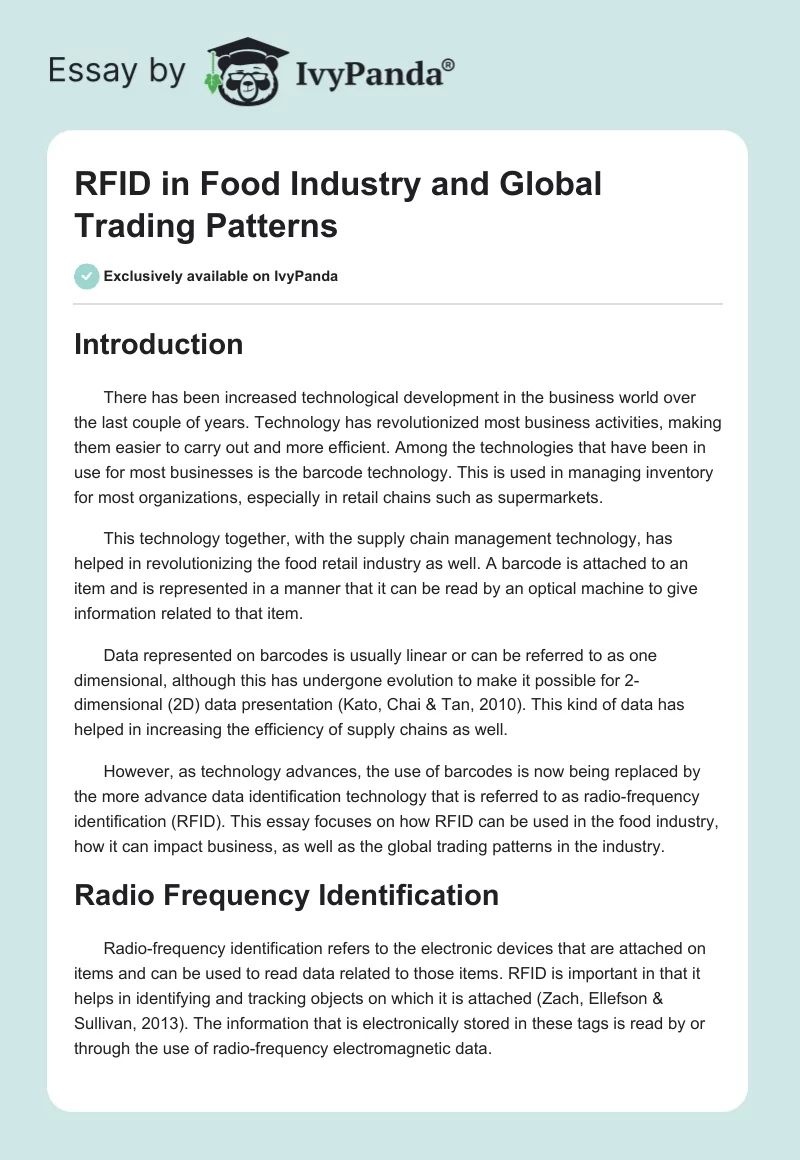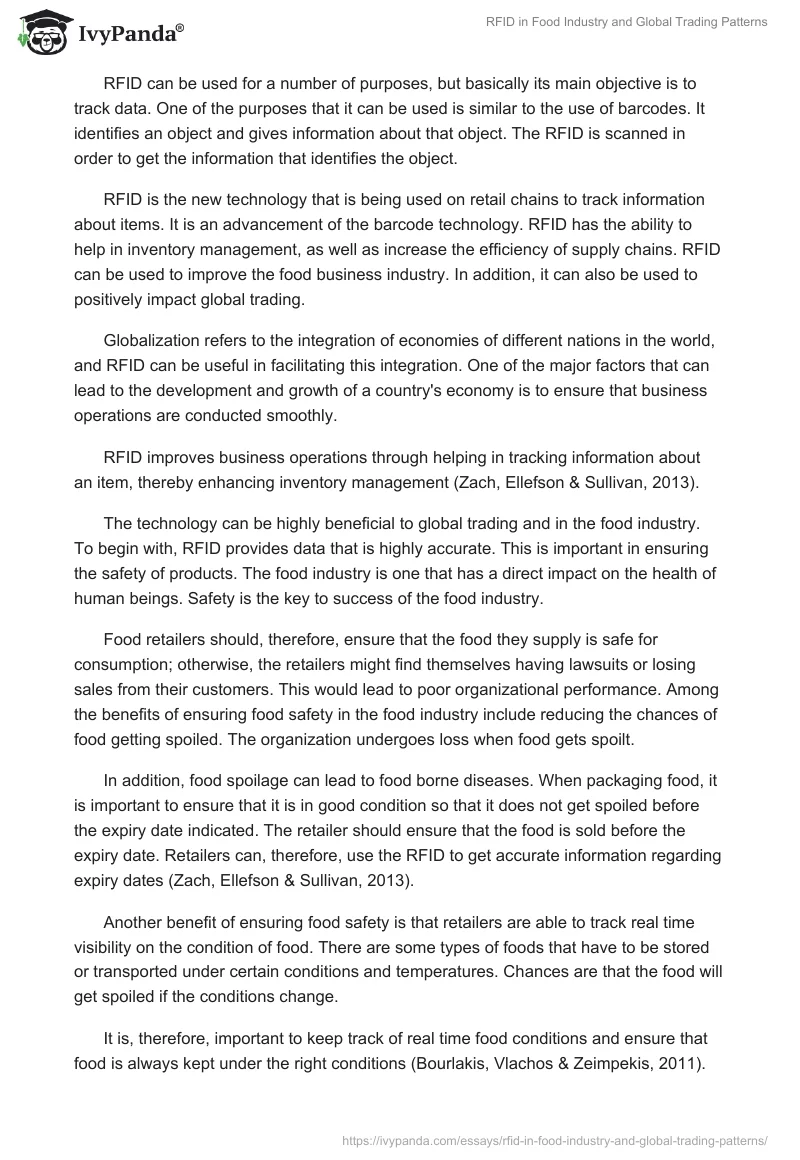Introduction
There has been increased technological development in the business world over the last couple of years. Technology has revolutionized most business activities, making them easier to carry out and more efficient. Among the technologies that have been in use for most businesses is the barcode technology. This is used in managing inventory for most organizations, especially in retail chains such as supermarkets.
This technology together, with the supply chain management technology, has helped in revolutionizing the food retail industry as well. A barcode is attached to an item and is represented in a manner that it can be read by an optical machine to give information related to that item.
Data represented on barcodes is usually linear or can be referred to as one dimensional, although this has undergone evolution to make it possible for 2- dimensional (2D) data presentation (Kato, Chai & Tan, 2010). This kind of data has helped in increasing the efficiency of supply chains as well.
However, as technology advances, the use of barcodes is now being replaced by the more advance data identification technology that is referred to as radio-frequency identification (RFID). This essay focuses on how RFID can be used in the food industry, how it can impact business, as well as the global trading patterns in the industry.
Radio Frequency Identification
Radio-frequency identification refers to the electronic devices that are attached on items and can be used to read data related to those items. RFID is important in that it helps in identifying and tracking objects on which it is attached (Zach, Ellefson & Sullivan, 2013). The information that is electronically stored in these tags is read by or through the use of radio-frequency electromagnetic data.
RFID can be used for a number of purposes, but basically its main objective is to track data. One of the purposes that it can be used is similar to the use of barcodes. It identifies an object and gives information about that object. The RFID is scanned in order to get the information that identifies the object.
RFID is the new technology that is being used on retail chains to track information about items. It is an advancement of the barcode technology. RFID has the ability to help in inventory management, as well as increase the efficiency of supply chains. RFID can be used to improve the food business industry. In addition, it can also be used to positively impact global trading.
Globalization refers to the integration of economies of different nations in the world, and RFID can be useful in facilitating this integration. One of the major factors that can lead to the development and growth of a country’s economy is to ensure that business operations are conducted smoothly.
RFID improves business operations through helping in tracking information about an item, thereby enhancing inventory management (Zach, Ellefson & Sullivan, 2013).
The technology can be highly beneficial to global trading and in the food industry. To begin with, RFID provides data that is highly accurate. This is important in ensuring the safety of products. The food industry is one that has a direct impact on the health of human beings. Safety is the key to success of the food industry.
Food retailers should, therefore, ensure that the food they supply is safe for consumption; otherwise, the retailers might find themselves having lawsuits or losing sales from their customers. This would lead to poor organizational performance. Among the benefits of ensuring food safety in the food industry include reducing the chances of food getting spoiled. The organization undergoes loss when food gets spoilt.
In addition, food spoilage can lead to food borne diseases. When packaging food, it is important to ensure that it is in good condition so that it does not get spoiled before the expiry date indicated. The retailer should ensure that the food is sold before the expiry date. Retailers can, therefore, use the RFID to get accurate information regarding expiry dates (Zach, Ellefson & Sullivan, 2013).
Another benefit of ensuring food safety is that retailers are able to track real time visibility on the condition of food. There are some types of foods that have to be stored or transported under certain conditions and temperatures. Chances are that the food will get spoiled if the conditions change.
It is, therefore, important to keep track of real time food conditions and ensure that food is always kept under the right conditions (Bourlakis, Vlachos & Zeimpekis, 2011). This will avoid any chances of spoilage and the effects that might result from food spoilage. In the global trade, food might be manufactured in one location and required to be transported over long distances for sale.
If the right information regarding the food is not captured, then there might be unthinkable loss due to spoilage during transportation. To enhance global trade in the food industry, it is important to use the RFID to avoid massive losses from such reasons.
Efficiency of the food chain supply is vital for the success of the industry in the global scene. For instance, multinationals are highly significance in the global trade. Multinationals should have highly effective and efficient supply chains if they are to prosper. For them to ensure efficiency, multinationals need to keep good track records of the products they supply.
They also need to ensure that their supply chains are efficient. RFID is one sure way of ensuring and maintaining good food supply chains. The technology helps in gathering accurate and detailed information regarding a product; hence it is easy to plan for the product’s supply.
Cost effectiveness is the other factor that is important in any business organization. It is imperative to note that every business organization is established with the major aim of making profits. In order for a business to make high profits, there are a number of aspects it should look up to. For instance, the business should ensure that it secures a large share of the markets to ascertain high level of sales, which translate into profits.
In addition, the organization should ensure that the costs of operation are kept at a low level. Lower costs mean that the profits will be higher. RFID has the ability to help the food industry maintain effective costs and improve profitability. Supply chains in the food industry have been ineffective for over a decade, a situation that has affected profitability in the food business (Haasis, Kreowski & Scholz-Reiter, 2008).
To counter this, business people in this industry started looking for ways in which they could improve the supply chains in order to increase the profitability and performance of businesses. They came up with various techniques in this bid (Haasis, Kreowski & Scholz-Reiter, 2008).
For instance, the Automatic Replenishment Program (ARP) is one of the techniques that were established (Reyes, 2005). However, this program was expensive ad cost ineffective, thus it negatively affected profitability of the food business. The cost of inventory management increased, as well as the inventory levels. It is after this that the RFID was established to improve this situation.
As it has been mentioned earlier in this essay, RFID has the ability to maintain cost effective management of inventory. Therefore, RFID can have a positive impact in the retail food industry by helping in the development of global trading in the industry. It is worth noting that the general cost of running a global business is high.
Therefore, the managers and leaders of global organizations should find ways to reduce these costs to increase profitability. RFID is one of the ways of ensuring profitability in the retail food industry. Other benefits that the RFID can have in the food industry and that can help the development of businesses in the industry globally include attainment of customer satisfaction (Bourlakis, Vlachos & Zeimpekis, 2011).
This is because customers are able to get better services from the organizations. Tracking and keeping proper records of products helps the management to improve customer services. RFID also improves container management and increases the competitive advantage of the organization.
Conclusion
As business operations become complex due to increased competition and globalization, it is important for organizations to come up with technologies that can help them keep up with the changing trends. The food industry is one that is very competitive.
RFID is a technology that can be used to give organizations competitive advantage. The technology helps in tracking information regarding products, thereby improving supply chain management and ensuring cost effectiveness. Therefore, RFID technology has positive impacts on the food industry and global trade in general.
Reference List
Bourlakis, M, Vlachos, IP & Zeimpekis, V 2011, Intelligent agrifood chains and networks, Wiley-Blackwell, Chichester, West Sussex
Haasis, H-D, Kreowski, H-J & Scholz-Reiter, B 2008, Dynamics in logistics: First international conference, LDIC 2007, Bremen, Germany, August 2007: proceedings, Springer, Berlin
Kato, H, Chai, D & Tan, KT 2010, Barcodes for mobile devices, Cambridge University Press, Cambridge
Reyes, PM 2005, ‘Future impacts of RFID on e-supply chains in grocery retailing’ Supply Chain Management: an International Journal, vol. 10, no. 2 pp. 134-142
Zach, L, Ellefson, W & Sullivan, DM 2013, Improving import food safety, Wiley-Blackwell, Ames, IO


